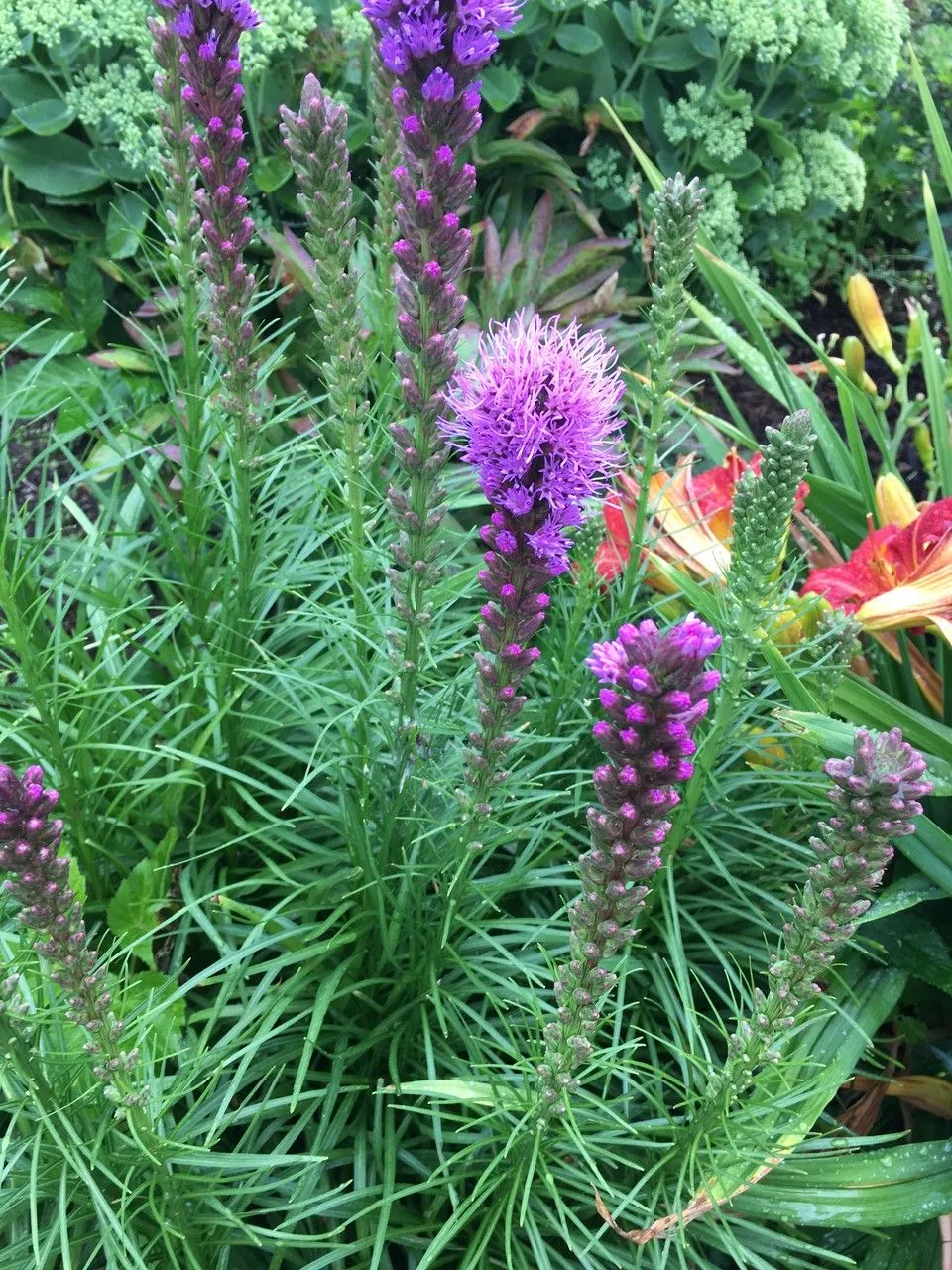
Author: (L.) Willd.
Bibliography: Sp. Pl., ed. 4, 3: 1636 (1803)
Year: 1803
Status: accepted
Rank: species
Genus: Liatris
Vegetable: False
Observations: E. Canada to NC. & E. U.S.A.
Marsh blazingstar, known scientifically as Liatris spicata, is a captivating and resilient perennial plant belonging to the Asteraceae family. Officially cataloged in the fourth edition of “Species Plantarum” in 1803, it was first described by the botanist Carl Linnaeus and later refined by Willdenow, marking its historical significance in botanical literature.
This species flourishes across a wide geographical range, primarily spanning from Eastern Canada down through North Carolina and embracing much of the Northeastern United States. Its presence in these diverse regions underscores its adaptability and ecological prowess. The plant thrives in marshes and moist meadows, where it contributes to the vibrant tapestry of native flora.
Marsh blazingstar is renowned for its striking floral display. Tall, slender spikes adorned with dense clusters of purple, tubular flowers create a dramatic visual spectacle from midsummer to early fall. These blossoms not only add aesthetic value to natural landscapes and cultivated gardens alike but also play a crucial role in supporting local ecosystems by attracting pollinators such as bees, butterflies, and other beneficial insects.
The foliage of Liatris spicata is relatively unassuming compared to its vibrant flowers. Its narrow, grass-like leaves form a basal clump at the plant’s base, providing an understated yet graceful contrast to the towering floral spikes. This morphological adaptation allows the plant to maximize its exposure to sunlight, fostering robust growth and abundant flowering.
Cultivating Marsh blazingstar is a rewarding endeavor for gardeners and landscapers seeking to enhance biodiversity and aesthetic appeal. Preferring well-drained soils and full sun to partial shade, it proves to be relatively low maintenance. Its drought tolerance and resistance to common garden pests further contribute to its popularity among native plant enthusiasts and conservationists.
In summary, Marsh blazingstar (Liatris spicata) is a remarkable perennial that not only embellishes our natural and cultivated spaces with its stunning purple flower spikes but also serves as a vital component of the ecosystems it inhabits. Its historical botanical classification, widespread geographical distribution, and ecological contributions underline the intrinsic value and enduring appeal of this Asteraceae family member.
Eng: blazingstar, button snakewort, dense blazing star, florist gayfeather, florist or marsh gayfeather, gayfeather, marsh blazingstar, marsh gayfeather, prairie-pine, dense blazing-star, blazing star, gay feather, marsh blazing-star, sessile blazing-star, sessile-headed blazing-star
Por: botão-de-raiz-cobra, estrela-brilhante, pluma-brilhante
Dan: lampepudser, langakset pragtskær
Deu: prachtscharte, ährige prachtscharte
Swe: rosenstav
Fra: liatris à épi
En: Marsh blazingstar, Marsh gayfeather, Gayfeather, Button snakewort, Florist gayfeather, Blazingstar, Prairie-pine, Dense blazing star, Florist or marsh gayfeather, Dense blazing-star, Blazing star, Gay feather, Marsh blazing-star, Sessile blazing-star, Sessile-headed blazing-star
Da: Lampepudser, Langakset pragtskær
Fr: Liatris à épi
De: Ährige Prachtscharte, Prachtscharte
Pt: Botão-de-raiz-cobra, Estrela-brilhante, Pluma-brilhante
Sv: Rosenstav
Taken Jul 21, 2017 by coria17 (cc-by-sa)
Taken Jul 30, 2021 by Espuelas Leticia (cc-by-sa)
Taken Dec 24, 2017 by emilie (cc-by-sa)
Taken Jul 19, 2018 by Dieter Wagner (cc-by-sa)
Taken Jul 3, 2018 by Donato Piccinno (cc-by-sa)
Taken Jul 9, 2020 by Anjie (cc-by-sa)
Taken Jul 7, 2020 by Jimmy Turrill (cc-by-sa)
Taken Sep 12, 2021 by Robin N (cc-by-sa)
Taken May 29, 2022 by Tristan Jaton-Maria (cc-by-sa)
Taken Jul 25, 2018 by Nicole QUANG (cc-by-sa)
© copyright of the Board of Trustees of the Royal Botanic Gardens, Kew.
© copyright of the Board of Trustees of the Royal Botanic Gardens, Kew.
© copyright of the Board of Trustees of the Royal Botanic Gardens, Kew.
Taken Jul 23, 2022 by Kai Best (cc-by-sa)
Taken Jul 22, 2022 by David Hocken (cc-by-sa)
Taken Jul 24, 2021 by Manuëlle (cc-by-sa)
Taken Jul 13, 2022 by Marieke Jelsma (cc-by-sa)
Taken Aug 1, 2019 by Kjetil Hårtveit (cc-by-sa)
Taken Jan 1, 1900 by EOL − John Hilty (cc-by-nc)
Taken Jul 12, 2020 by Blanka Šulová (cc-by-sa)
Taken Jul 22, 2021 by Wisconsin Hiker (cc-by-sa)
Taken Jul 29, 2022 by Kai Best (cc-by-sa)
Taken Jul 16, 2020 by Imke Hgj (cc-by-sa)
Taken Aug 11, 2019 by dewarlez sophie (cc-by-sa)
Taken Oct 13, 2021 by maryvonne stallaerts (cc-by-sa)
Taken Sep 4, 2022 by William Coville (cc-by-sa)
Taken Aug 31, 2020 by Ha Anna (cc-by-sa)
Taken Jul 15, 2022 by frans van drielen (cc-by-sa)
Taken Nov 3, 2020 by sylvie toupin (cc-by-sa)
Taken Jul 17, 2021 by tufty_jam_bean (cc-by-sa)
Taken Aug 20, 2022 by Jimmy Turrill (cc-by-sa)
Taken Aug 4, 2021 by Marion Thepaut (cc-by-sa)
Taken Jul 9, 2004 by EOL − Steven J. Baskauf (cc-by-nc-sa)
Growth form>: Rhizomatous
Growth habit>: Forb/herb
Growth rate>: Slow
Ph maximum: 7.5
Ph minimum: 5.6
Family: Myrtaceae Author: (F.Muell.) K.D.Hill & L.A.S.Johnson Bibliography: Telopea 6: 402 (1995) Year: 1995 Status:…
Family: Rubiaceae Author: Pierre ex A.Froehner Bibliography: Notizbl. Bot. Gart. Berlin-Dahlem 1: 237 (1897) Year:…
Family: Sapindaceae Author: Koidz. Bibliography: J. Coll. Sci. Imp. Univ. Tokyo 32(1): 38 (1911) Year:…
Family: Asteraceae Author: A.Gray Bibliography: Pacif. Railr. Rep.: 107 (1857) Year: 1857 Status: accepted Rank:…
Family: Fabaceae Author: Medik. Bibliography: Vorles. Churpfälz. Phys.-Ökon. Ges. 2: 398 (1787) Year: 1787 Status:…
Family: Aspleniaceae Author: (Cav.) Alston Bibliography: Bull. Misc. Inform. Kew 1932: 309 (1932) Year: 1932…